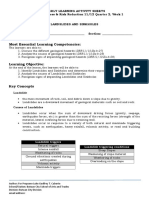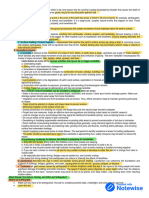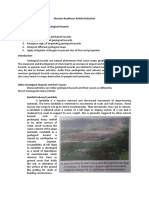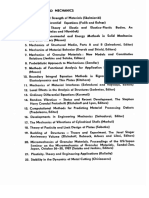Geological Hazard
Geological Hazard
Uploaded by
Gavriell PanganCopyright:
Available Formats
Geological Hazard
Geological Hazard
Uploaded by
Gavriell PanganOriginal Title
Copyright
Available Formats
Share this document
Did you find this document useful?
Is this content inappropriate?
Copyright:
Available Formats
Geological Hazard
Geological Hazard
Uploaded by
Gavriell PanganCopyright:
Available Formats
GEOLOGICAL HAZARD Landslides are also aggravated by human activities,
such as :
Geological hazards are natural phenomena that • deforestation, cultivation and construction, which
cause major problems all over the world. The expansion destablize the already fragile slopes.
and development of cities lead to an increase in impact • vibrations from machinery or traffic
and damaged due to geological hazards. In general, • blasting (e. g as miners normally do)
most of the geological hazards are related to natural • earthwork which alters the shape of a slope, or which
conditions, although some may be due to human imposes new loads on an existing slope
activities. Aside from earthquakes and volcanic • in shallow soils, the removal of deep-rooted
eruptions, which are the common geological hazards vegetation that binds colluvium to bedrock (e. g kaingin
causing massive devastation, there are other related farming system)
hazards that may also cause minor to major destruction • construction works, agricultural or forestry activities
to people and community. (e. g logging) which change the amount of water
infiltrating the soil.
Rainfall-Induced Landslide Effects of Landslides
A landslide is a massive outward and downward Landslides cause property damage, injury and
movement of slope-forming materials. The term death and adversely affect a variety of resources. For
landslide is restricted to movements of rocks and soil example, water supplies, fisheries, sewage disposal
masses. These masses may range in size up to entire systems, forests, dams and roadways can be affected
mountainsides. Their movements may vary in velocity. A for years after a slider event.
landslide is initiated when a section of a hill slope or The negative economic effects of landslides
sloping section of a sea bed is rendered too weak to include the cost to repair structures, loss of property
support its own weight. This is generally tiggered by value, disruption of transportation routes, medical costs
other natural hazards such as prolonged, heavy rainfall in event of injury and indirect costs such as lost timber
or by other sources of water which increase the water and lost fish stocks. Water availability, quantity and
content of the slope materials. quality can be affected by landslides. Geotechnical
studies and engineering projects to assess and stabilize
potentially dangerous sites can be costly.
Causes of Landslide
Landslide occur when a slope changes from a Preparedness and Mitigation (What to do before)
stable to an unstable condition. A change in the stability • Coordinate with the Mines and Geosciences
of a slope can be caused by a number of factors, acting Bureau (MGM) regarding the landslide
together or alone. susceptibly of the area concerned.
• Consult a professional for advice most
Natural causes of landslide include: appropriate for the site for landslide mitigation
• groundwater (pore water) pressure acting to and prevention.
destabilize the slope • Reinforce the foundation and walls of structures
• loss or absence of vertical vegetative structure, when needed.
soil nutrients, and soil structure (e.g. after a • Develop a land use plan, ensuring that site
wildfire) developments are compatible with the
• erosion of the toe of a slope by rivers or ocean conditions and limitations of the natural
waves environment.
• weakening of a slope through saturation by • Promote public awareness and involvement of
snow melt, glaciers melting, or heavy rains landslide mitigation.
• earthquakes adding loads to barely stable slope • Develop a community preparedness and
• earthquake-caused liquefaction destabilizing evacuation plan.
slopes • Maintain a list of contact numbers during
• volcanic eruptions emergencies.
• Plant grasses to cover slopes or build riprap to
prevent soil erosion.
• Contact regular drills on evacuation procedures.
• Recommend to proper authorities the Types of sinkholes
construction of channels, catchments, basins,
dams, leeves and similar structures to protect Dissolution sinkholes
the community. Dissolution of the limestone or dolomite is most
intensive where the water first contacts the rock
Response (What to do during) surface. Aggressive dissolution also occurs where flow is
• Evacuate the community immediately if warned focused in preexisting openings in the rock, such as
of an impending landslide along joints, fractures and bedding planes, and in the
• Get out of the house/building as soon as zone of water-table fluctuation where groundwater is in
possible when rumbling sounds are heard from contact with the atmosphere.
upstream or when trembling of the ground is
heard. Run across a slope, not downwards.
• Stay away from the path of landslides debris or
seek refuge behind a sturdy tree or structure.
Rehabilitation (What to do after)
• Ask proper authorities to thoroughly examine
damaged structures and utilities before using
these.
• Stay away from the landslides area. There may Cover-subsidence sinkholes
be danger of additional landslides. Cover-subsidence sinkholes tend to develop
• Check caution injured and trapped persons gradually where the covering sediments are permeable
within the landslide area. Direct rescuers to and contain sand. In areas where cover materials is
their locations. thicker or sediments contain more clay, cover-
• Listen to local radio or television station for the subsidence sinkholes and relatively uncommon, are
latest emergency information. smaller, and may go undetected for long periods.
• Seek the advice of an expert for evaluating
landslide hazards or designing corrective
techniques to reduce landslide risk.
•
Sinkholes
Sinkholes are common where the rock below
the land surface is limestone, carbonate rock, salt beds,
or rocks that can naturally be dissolved by groundwater
circulating through them. As the rock dissolves, spaces
and caverns develop underground. Sinkholes are Cover collapsed sinkholes
dramatic because the land usually stays intact for a Cover-collapsed sinkholes may develop abruptly
while until the underground spaces just get too big. If (over a period of hours) and cause catastrophic
there is not enough support for the land above the damages. They occur when the covering sediments
spaces then a sudden collapse of the land surface can contain a significant amount of clay. Over time, surface
occur. These collapses can be small, or they can be huge drainage, erosion and deposition of sinkhole develop
and can occur where a house or road is on top. into a shallower bowl-shaped depression.
Sinkholes can vary from a few feet to hundreds
of acres and from less than 1 to more than 100 feet
deep. Some are shaped like shallow bowls or saucent
whereas others have vertical walls; some hold water
and form natural ponds.
even a particular landslides doesn't reactivate, the
What to do when there is a sinkhole? underlying geologymakes the whole region unstable
1.) Before buying a land or house, do a research if the and susceptible to landslides. If a particular landslide
area is prone to the occurrence of sinkhole. doesn't reactivate, the underlying geology makes the
2.) Keep a whistle in your pocket or at your home. This whole region unstable and susceptible landslides.
will serve as your signaling device.
3.) If you are already living in an area where there is 2. Tension Cracks
frequent occurrence of sinkholes consider moving to a Tension cracks are created by the stress of
safer place. geological materials putting apart. They often mark the
eventual landslide scarp, the top edge of the failure
During zone. They can be identified as road segments that
1.) When you are trapped in a sinkhole, try to make a constantly need long, thin patches, or out in the wild as
noise but do not tap or dig the soil and rocks around actual cracks in the ground. Tensuon cracks above an
you because there is a possibility that your movement existing landslide can hint at future reactivation.
could create soil erosion. However, if tension cracks are found on flat ground
2.) If you have a cell phone call for help or rescue. they're still being created by extensional stress, but are
3.) Stay calm, Save your body energy and wait for more likely related to a fault than a landslide.
people that may pass by and once it happens, call them
for help and rescue. 3. Things Moving
Observable movement and deformation of
After things are also indicated of an impending landslide. The
1.) If you are caught by a sinkhole and able to survive it, most common among these is that trees are bending up
check yourself for any injuries and immediately call in a J-curve as a sign that the ground slops out from
for EMS assistance. under them. A patch od angled forest on a slope or J-
curved trees somewhere can be good indicator that the
Sinkholes can be human induced ground is less solid than it seeks. While so far a rapid
New sinkholes have been correlated to land-use landslide, especially if you find intension cracks farther
practice, especially from groundwater pumping and uphill. Inside structures, signs of slow shifting can be
from construction and development practices. Sinkholes floors tilting, doors no longer closing properly, or
can also form when natural water-drainage patterns are broken utilities. Creaking and cracking can also be
change an new water-diversion system are developed. warning signs.
Some sinkholes form when the land surface is changed,
such as when industrial and runoff-storage ponda are 4. Water Doing Something Different
created. The substantial weight of the new material can Another warning sign for a landslide is changes in water
trigger an underground collapse of supporting material, flow. The sudden arrival of water in a spring, seep, or
thus causing a sinkhole. wet ground somewhere that is usually dry indicates that
something changed, and this change is not to be
Sign of Impending Geological Hazards trusted. The sudden disappearance of water is just as
The following are some of the observable signs that a ominous. Water levels in a creek suddenly dropping can
landslide is possible to occur in a particular area: be due to an upstream obstruction like a landslide-dam
that will break and send a debris flow rushing
downstream. A debris flow is a very wet, very mobile
A. Landslide landslide where water is loaded with trees, mud, rock,
1. Earlier Landslide as an indicator. and everything else caught in the torrent. Low water
Observing old landslides is a good indication level precedes the arrival of the debris flow surge.
that the area has an unstable geology, and that more This list doesn't cover every possible sign of an
landslides are likely in the future. Multiple landslides impending landslide, nor does everything on this list
events in the same place can be retrogressive piecemeal immediately lead to landslide. Listed are warning signs
or reactivated. A reactivated landslide is where to help people recognize when it's time to hire an
something changed at an old, semi stable landslide, expert to assess a slope's stability, or to make people
triggering a new failure at the same location. By looking more aware that something is wrong.
around an area a whole lot of old landslides scarps and
deposits are seen, this is a pretty good indication that
Sinkholes
Sinkholes rarely strike without giving some
warning in the surrounding environment or in a nearby
home. Here are some signs to watch for they may
indicate a problem about the present and imminent
danger or sinkhole:
• Trees or fence posts that tilt or fall
• Foundations that slant
• New small ponds that appear after rain
• Cracks in the ground
• Sudden drainage of a pond
• Rapid appearance of a hole in the ground
• Dips, depressions, slopes that appear in a yard
• Dead patches of grass or plants
• Sinkholes in the neighborhood
• Wilted vegetation in a limited area
• Well water that is discolored or contaminated
with debris
• Cracking or buckling of home's concrete slab
• Prescence of odd bugs like slugs and centipedes
in the home
• Earthy odor in home after rain
• New or widening cracks separation between
walls and ceiling or floors
• Cracks in interior walls
• Cracks around door and windowframes
• Cracked grout between tiles
• Cracked tiles
• Stair step cracks in blocks or bricks
• Uneven floors, warping of hardwood, bulging or
sagging sections
• Doors or windows that don't open or close
easily
• Cracks in sheetrock near doors or windows
All homes are subject to settling characteristics.
Any of these signs could exist without the prescence of
a sinkhole. However, the presence of one or more of
these signs calls further careful observation and
abundance of caution.
You might also like
- Apqp Timing Chart-Macro Plan: ActivityDocument2 pagesApqp Timing Chart-Macro Plan: Activitysuchig8453750% (2)
- Robotics Book Unit 1 & 2Document33 pagesRobotics Book Unit 1 & 2arun193905No ratings yet
- Analyze The Causes of Geological HazardDocument13 pagesAnalyze The Causes of Geological HazardDaniel Arradaza100% (1)
- Chapter 6 Other Related Geological HazardsDocument19 pagesChapter 6 Other Related Geological HazardsreesespufffNo ratings yet
- Other Related Geological HazardsDocument35 pagesOther Related Geological HazardsCherry Pie Renon100% (1)
- Landslides: Group 3Document18 pagesLandslides: Group 3Ceejay QuimcoNo ratings yet
- DRRR - Q2 - Week 1Document14 pagesDRRR - Q2 - Week 1Nylinam67% (3)
- Chp6 Other Related Geological HazardDocument37 pagesChp6 Other Related Geological HazardYohana UymatiaoNo ratings yet
- Reviewer For HAZARDS. 23 24docx PDFDocument4 pagesReviewer For HAZARDS. 23 24docx PDFHanah Mae LimugNo ratings yet
- DRRR - Module 06 (Other Related Heological Hazards)Document10 pagesDRRR - Module 06 (Other Related Heological Hazards)elesis100% (1)
- DRRR PPT 1Document34 pagesDRRR PPT 1Kim Estrebella0% (1)
- Geologic HazardDocument6 pagesGeologic Hazardchloudchloecanta8No ratings yet
- DRRR Reviewer Q1Document5 pagesDRRR Reviewer Q1ariannealzagaNo ratings yet
- 12 StemDocument27 pages12 StemApril Joy LoreteNo ratings yet
- Other Geological HazardsDocument25 pagesOther Geological HazardsDerwin AraNo ratings yet
- DRRR Reviewer OCT QuizDocument4 pagesDRRR Reviewer OCT QuizLoui ChiNo ratings yet
- Module 6 Geological HazardDocument14 pagesModule 6 Geological Hazardjaslor100% (1)
- Group 2 DRRRDocument4 pagesGroup 2 DRRRanniebcortez8801No ratings yet
- Geologic Hazards DRRRDocument37 pagesGeologic Hazards DRRRnunezreneboy1No ratings yet
- HazardsDocument22 pagesHazardsGLADYS OLIVEROS100% (1)
- DRRR - Chapter 6Document14 pagesDRRR - Chapter 6Roccie Dawn MisaNo ratings yet
- Performance Task On DRRRMDocument17 pagesPerformance Task On DRRRMAdrian John ManalotoNo ratings yet
- Cor 010 Reviewer by CarylleDocument6 pagesCor 010 Reviewer by CaryllePaolo DioquinoNo ratings yet
- DRRR_Q2_W1-1Document51 pagesDRRR_Q2_W1-1johnreysmith147No ratings yet
- DRRR FinalsDocument22 pagesDRRR Finalsdenisecatubag15No ratings yet
- Group 1 DRRRDocument3 pagesGroup 1 DRRRanniebcortez8801No ratings yet
- DRRR - Q2 - Module 1 - 2Document66 pagesDRRR - Q2 - Module 1 - 2Donna Rose M. BalamadNo ratings yet
- Rainfall Induced Landslides: Group 2Document13 pagesRainfall Induced Landslides: Group 2Bea Dacillo Bautista100% (1)
- Natural HazardsDocument28 pagesNatural HazardsAlmira SantosNo ratings yet
- PM 211 Module 5Document14 pagesPM 211 Module 5Louray JeanNo ratings yet
- DRR L10-Landslides-and-Sinkholes G12Document74 pagesDRR L10-Landslides-and-Sinkholes G12ydarciaga29No ratings yet
- LANDSLIDEDocument23 pagesLANDSLIDEkereysha daradalNo ratings yet
- Natural HazardsDocument28 pagesNatural HazardsKing BascosNo ratings yet
- Landslide DRRRDocument9 pagesLandslide DRRRActor c. AjhoyNo ratings yet
- Disaster Risk ReductionDocument30 pagesDisaster Risk ReductionRoselyn Estrada MunioNo ratings yet
- 4 DRRRDocument11 pages4 DRRRJohn Lloyd RaponNo ratings yet
- LandslideDocument28 pagesLandslideSurendra Bam100% (2)
- Geological Processes and HazardDocument26 pagesGeological Processes and HazardErick GaviolaNo ratings yet
- Landslides Geology LectureDocument34 pagesLandslides Geology LectureRehan Hakro100% (1)
- DRRR ReviewerDocument7 pagesDRRR Reviewerlim587273No ratings yet
- Nature of Sedimentation Problems: 1. GeneralDocument10 pagesNature of Sedimentation Problems: 1. GeneralAnna RosythaNo ratings yet
- Geological HazardsDocument11 pagesGeological HazardsSaldan Quito100% (1)
- DRRM NotesDocument9 pagesDRRM NotesARC brillantesNo ratings yet
- Landslide 2Document9 pagesLandslide 2gwqfx4cnmgNo ratings yet
- DRRRDocument5 pagesDRRRmyouialyNo ratings yet
- Q2 Lesson 1 Geological Hazards2Document31 pagesQ2 Lesson 1 Geological Hazards2Janrick Matiga NodaloNo ratings yet
- What Are Landslides?: Mark Zarco Institute of Civil Engineering University of The Philippines DilimanDocument35 pagesWhat Are Landslides?: Mark Zarco Institute of Civil Engineering University of The Philippines DilimanJomalyn TisangNo ratings yet
- Nope IiiDocument7 pagesNope IiiHyun Chong ParkNo ratings yet
- Steeper Slopes Permeable Sands Above Impermeable Layers: A) Natural FactorsDocument18 pagesSteeper Slopes Permeable Sands Above Impermeable Layers: A) Natural FactorsDivyagarapatiNo ratings yet
- Reporting OutlinedDocument9 pagesReporting OutlinedElsie TevesNo ratings yet
- Disaster Management "Landslides": Presented By-Balram Chaudhary Asst ProfessorDocument8 pagesDisaster Management "Landslides": Presented By-Balram Chaudhary Asst ProfessorBalramNo ratings yet
- DRRR ReportingDocument24 pagesDRRR ReportingFebe JamieNo ratings yet
- Natural Hazards/ Disasters Causes, Characteristics and Possible Remedial MeasuresDocument40 pagesNatural Hazards/ Disasters Causes, Characteristics and Possible Remedial MeasuresAfsar Ullah WazirNo ratings yet
- Reviewer DRRR Finals Pt1Document5 pagesReviewer DRRR Finals Pt1Loui ChiNo ratings yet
- Effective StudyDocument2 pagesEffective Studysawanthv11No ratings yet
- DRR ReviewerDocument4 pagesDRR ReviewersorerikarubyNo ratings yet
- Geological Hazards FinalDocument42 pagesGeological Hazards FinalMark Elben100% (4)
- Natural Disasters and Prevention EishaDocument16 pagesNatural Disasters and Prevention EishaMirha FatimaNo ratings yet
- Geological HazardsDocument38 pagesGeological HazardsNikkaNo ratings yet
- Are You Prepared For Natural DisastersDocument1 pageAre You Prepared For Natural Disastersandrewzafra123No ratings yet
- Landslideandsoilerosion 160321131400Document32 pagesLandslideandsoilerosion 160321131400mardiradNo ratings yet
- 03 - Topology Optimization For Additive Manufacturing As An Enabler For Light Weight Flight HardwareDocument22 pages03 - Topology Optimization For Additive Manufacturing As An Enabler For Light Weight Flight HardwareKalyude DiógenesNo ratings yet
- LightDocument4 pagesLightCherissa Mae TamayoNo ratings yet
- (Sergiu T. Chiriacescu (Eds.) ) Stability in The DyDocument204 pages(Sergiu T. Chiriacescu (Eds.) ) Stability in The DyHugo CostaNo ratings yet
- Unit 6 I ADCDocument29 pagesUnit 6 I ADCcacaNo ratings yet
- Brewery Product Guide - FINAL 0619 PDFDocument3 pagesBrewery Product Guide - FINAL 0619 PDFVictor LeiNo ratings yet
- Medvedev, V. - Be A Man, BarankinDocument108 pagesMedvedev, V. - Be A Man, BarankinaNo ratings yet
- Poems Questions Notes by AqeelDocument7 pagesPoems Questions Notes by AqeelAqeel AhmadNo ratings yet
- Pseudo Forces in Uniformly Rotating FrameDocument21 pagesPseudo Forces in Uniformly Rotating FramePuspalata DashNo ratings yet
- Hydraulic Design and Experimental Investigation of Roof Drainage SystemDocument12 pagesHydraulic Design and Experimental Investigation of Roof Drainage SystemaishNo ratings yet
- Session 2016 - 2021: Narmada Bachao ANDOLAN: A Case StudyDocument27 pagesSession 2016 - 2021: Narmada Bachao ANDOLAN: A Case StudyDushyant Singh ChauhanNo ratings yet
- Full Test Bank For Elementary Statistics A Step by Step Approach 10Th Edition Allan Bluman PDF Docx Full Chapter ChapterDocument36 pagesFull Test Bank For Elementary Statistics A Step by Step Approach 10Th Edition Allan Bluman PDF Docx Full Chapter Chapterstarched.welsher.vkb7100% (17)
- Some Gas Dispersion Characteristics of Mechanical Otation MachinesDocument9 pagesSome Gas Dispersion Characteristics of Mechanical Otation MachinesjvchiqueNo ratings yet
- RADWAG Data Sheet Pue-C315Document3 pagesRADWAG Data Sheet Pue-C315Godfried SimonNo ratings yet
- Lesson Plan For ListeningDocument3 pagesLesson Plan For Listeningfragile_49No ratings yet
- CBSE Class - 12 - BiologyDocument7 pagesCBSE Class - 12 - BiologyAanav MittalNo ratings yet
- AnalysisTools PowerSpectraDocument13 pagesAnalysisTools PowerSpectraTaniya SahaNo ratings yet
- Chulu Epa Shep Approach Progress ReportDocument1 pageChulu Epa Shep Approach Progress Reportjonathan baloyiNo ratings yet
- Oumfs-Iiib Intelligent Near Infrared Moisture MoDocument5 pagesOumfs-Iiib Intelligent Near Infrared Moisture MoClouds Osteen JoreinNo ratings yet
- Brazed Plate Heat Exchanger Serie-CSP-CSPIDocument29 pagesBrazed Plate Heat Exchanger Serie-CSP-CSPIСергей КолесниковNo ratings yet
- Marine Pollution: - by Antora Basumata 19NA60R06, M.Tech - 1 Year Dept. of Ocean Eng. & Naval Arch. IIT KharagpurDocument14 pagesMarine Pollution: - by Antora Basumata 19NA60R06, M.Tech - 1 Year Dept. of Ocean Eng. & Naval Arch. IIT KharagpurVictor DaggersNo ratings yet
- SI0240Document12 pagesSI0240Kavi SaikrishnaNo ratings yet
- 6th Mathematics Term I EM - WWW - Tntextbooks.inDocument136 pages6th Mathematics Term I EM - WWW - Tntextbooks.inThirumal ThirumalNo ratings yet
- Lecture 3 - DNA Structure PDFDocument6 pagesLecture 3 - DNA Structure PDFАбу ДжудNo ratings yet
- LDDocument10 pagesLDSpk SudhinNo ratings yet
- Amol DadaDocument2 pagesAmol DadaNighute SureshNo ratings yet
- Itinerary (E5968)Document9 pagesItinerary (E5968)larry beyondbordersNo ratings yet
- Banker's Algorithms-Safety AlgorithmDocument2 pagesBanker's Algorithms-Safety AlgorithmishitaNo ratings yet
- Final Exam ReviewDocument12 pagesFinal Exam Reviewhotstuff21062005No ratings yet

























































































